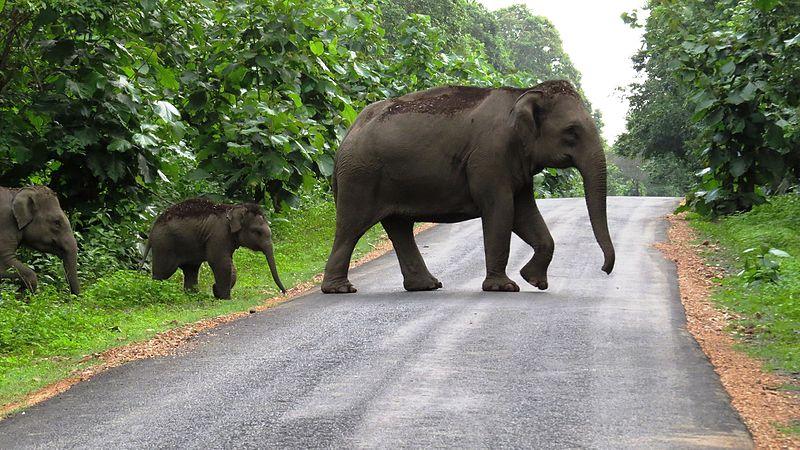Odisha: Central Panel Red Flags Mining Activities in Elephant Habitat Near Hockey World Cup Venue

Representational Image. Image Courtesy: Wikimedia Commons
New Delhi: A proposal to clear 112 hectares of forestland from a prime elephant habitat in western Odisha for an iron ore mining project will not only impact the inter-state movement of pachyderms across Chhattisgarh and Jharkhand, but will also result in greater human-wildlife conflict, a central government expert panel has found.
The mining project, belonging to a subsidiary company of billionaire businessman Sajjan Jindal’s steel conglomerate JSW Steel, is proposed in Odisha’s Sundargarh district, barely an hour’s drive from Rourkela, which will jointly host the World Cup Hockey tournament in January.
The panel, comprising officials from the Union Ministry of Environment, Forests and Climate Change (“the Ministry”) and the Central government-controlled Dehradun-based autonomous organisation, Wildlife Institute of India, prepared a report following a site visit to Bonai forest division where the mining project is proposed. The panel was formed to examine a proposal by Bhushan Steel and Power Limited to divert forest land for the Netrabandha Pahar Iron Ore block that was allotted to it by the Narendra Modi government in May 2017. In March last year, JSW Steel had been acquired Bhushan Steel and Power Limited which specialises in manufacturing various steel products.
“The area is one of the prime elephant habitats as elephants keep on moving from one part of the habitat to the other. The district shares its boundaries with Jharkhand and Chhattisgarh. Therefore, the elephant population found in this area is part of the larger elephant population moving across three states namely, Odisha, Jharkhand and Chhattisgarh. Any adverse impact on this population will result in more dispersal into human habitation and human-elephant conflict not only [in] Odisha but across all the three states,” the expert panel has noted in its report.
The panel also found that apart from 26 mines which are operational in the Bonai division – spread across a massive area of 2,900 square kilometres in the Sundargarh district – there are at least 50 non-operational mines. Besides, proposals are also in various stages of approval for diverting forest land for 72 additional mining projects. The panel has minced no words in stating that the impact of any further mining on the wildlife of the area will be adverse.
“Any additional mining lease in the area shall impact the movement of elephants not only in the Sundargarh district but also in the adjoining states of Jharkhand and Chhattisgarh,” the report states.
In a meeting held on December 9, the Ministry’s Forest Advisory Committee (FAC)- which evaluates the anticipated consequences of proposals to divert forestland for industrial purposes, asked the Odisha government to conduct an assessment of the impacts that the operational and proposed mining projects have on the elephant habitat.
“Keeping in view the larger landscape involving the elephant movement and recommendation made in the report of the team of MoEF&CC and WII officials, comments should be furnished on the likely impacts of the various mining leases which are currently operational, closed or proposed in the area on the wildlife in general and elephant habitat, their movement, protection and conservation of elephant corridors, after detailed scrutiny and analysis of the existing field information,” said the FAC.
The FAC has also directed the state government to study the efficacy of site-specific plans for each mining project in the area to ascertain if these alone are enough to address issues of elephant habitat and movement in Bonai or if a broader management plan for elephants is required.
The expert panel has stated in its report that it is necessary to ascertain why 50 mines are lying non-functional in the Bonai division. The panel has recommended that “attempts should be made to revive these mines or these mines (if established over forest areas) should be handed back to the forest department if no mining is envisaged.”
Officials of the forest department of Odisha told this correspondent that these 50 mines have been abandoned by their owners after the expiry of their lease periods. It is not immediately clear how many of these mining projects have applied for the renewal of leases. But data from the forest department shows that rampant pilfering of minerals is taking place from these abandoned mines.
Over the past three years, forest department officials have seized 32 vehicles carrying illegally quarried iron ore or manganese from the Bonai division. The department has seized more than 257 metric tons of iron ore and over 90 tonnes of manganese along with these vehicles.
“Whatever illegal mining has been taking place in these forests is from the abandoned mines. There have been no instances of mining without lease or forest clearance,” Divisional Forest Officer (DFO) of Bonai, Sanath Kumar N, told this reporter.
The issue of diversion of forest land in the prime elephant habitat of Bonai has reared its ugly head at a time when the Naveen Patnaik-led Odisha government has skipped conducting a census of pachyderms for the past six years. The last elephant census was conducted in Odisha in 2016-17 wherein the total number of pachyderms in the state was recorded as 1,976. Data from previous years show that there has been more or less a steady decline in the elephant population in Odisha. In the first census that was ever conducted in Odisha in the year 1979, the total number of elephants in the state was recorded at 2,044.
“The Odisha government has proffered no reason for skipping the elephant census for the past six years. As a result of clearing massive tracts of forest land for the purpose of mining activities, the human-elephant conflict has been on the rise across the state. There have been frequent reports of human-elephant conflict from the Bonai region,” Odisha-based wildlife activist Biswajit Mohanty told this reporter.
Odisha recorded as many as 1,145 instances of human-elephant conflict between April 2014 and January 2022. These incidents resulted in the deaths of 730 persons and left another 657 injured. In the period between March 2021 to January 2022, as many as 97 deaths owing to human-elephant conflicts were reported from across the state. The highest number of casualties (27) was reported during this period from Sundargarh district where the Bonai forest division is located.
A senior official of the state’s wildlife department informed this reporter that a census was being conducted at present for determining the total number of elephants as well as tigers in Odisha. As per the central expert panel’s report, instances of man-animal conflict are on the rise in Odisha despite the fact that there has been a marginal decline in the elephant population in the state. The panel has taken cognisance of cases reported in the human-wildlife conflict including deaths and injuries of human beings, killing of domestic cattle and damages to houses and agricultural crops.
It has also been observed that retaliatory killing of wild animals is also being reported from Odisha. In a period spanning the years between 2004-05 and 2009-10, as many as 331 elephant death cases were reported from Odisha including 55 deaths due to poaching for ivory and 96 deaths resulting from accidents (mainly electrocution). At the same time, 49 deaths were reported from natural causes while 82 deaths were due to diseases and 49 were for reasons which could never be ascertained.
The census of 2016-17 had put the total number of elephants in the Bonai division at 60. However, officials claim the number varies between 22 and 88 on the basis of daily monitoring. This huge variance in numbers has been attributed to the fact that pachyderms move through the Bonai forests from all directions including from Chhattisgarh and Jharkhand. The total number of elephant deaths in Bonai has been 28 in the last 10 years out of which 26 cases were from natural causes. One elephant had fallen prey to poaching in the year 2015-16 while another elephant was accidentally electrocuted in 2020-21 by a trap set up by certain local villagers to capture wild boars.
The writer is an independent journalist.
Get the latest reports & analysis with people's perspective on Protests, movements & deep analytical videos, discussions of the current affairs in your Telegram app. Subscribe to NewsClick's Telegram channel & get Real-Time updates on stories, as they get published on our website.
























